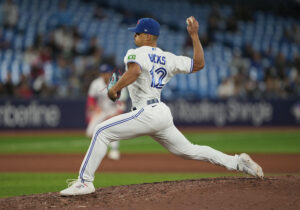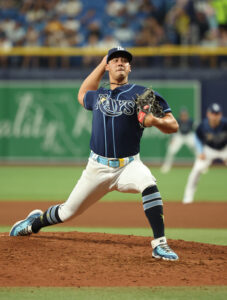After winning the 2023 World Series, the first in franchise history, the Rangers have a big decision to make. They can either rest on their laurels, having accomplished their ultimate goal well ahead of schedule, or they can double down, reconfirming their commitment to winning. There is no denying their aggressive approach over the last two years paid dividends, but will they take that as motivation to remain aggressive or as impetus to let their foot off the gas?
The Rangers have been relatively quiet this offseason, having made just two notable acquisitions: starting pitcher Tyler Mahle and reliever Kirby Yates. Mahle, 29, is recovering from Tommy John surgery and won’t return to the mound until midsummer at the earliest. Yates, 37 in March, overcame elbow problems of his own to pitch a full season in 2023, but at this point in his career, he looks more like a middle reliever than the All-Star he once was.
Meanwhile, several key contributors and high-paid veterans came off the books at the end of the 2023 season, including Jordan Montgomery, Mitch Garver, Martín Pérez, Jake Odorizzi, Aroldis Chapman, and Will Smith. In other words, this team has holes to fill and, at least in theory, should have money to spend.
However, after allocating significant resources to sign players like Corey Seager, Marcus Semien, Jon Gray, Jacob deGrom, and Nathan Eovaldi over the past two years, not to mention adding Max Scherzer at last year’s trade deadline, the Rangers’ estimated 2024 payroll already sits dangerously close to the first luxury tax threshold. According to Roster Resource, the team has just over $4MM left to spend before they’d have to pay the tax.
The Rangers paid the competitive balance tax for the first time this past season. The total bill came in around $1.8MM, a drop in the bucket compared to their payroll and a small price to pay for a World Series title. Nonetheless, managing partner Ray C. Davis “isn’t keen to start the season above the tax threshold” in 2024, according to Evan Grant of The Dallas Morning News. Grant has suggested as much at multiple points throughout the offseason, but he reemphasized the idea earlier this week. Specifically, he notes the higher surcharge for clubs that pay the tax multiple years in a row; teams pay a 20% tax on all overages their first year above the threshold, 30% in their second straight season, and 50% in subsequent seasons after that.
Grant also acknowledges that the Rangers, like several other teams, are dealing with uncertainty surrounding local TV revenue after Diamond Sports Group filed for bankruptcy earlier this year. That said, he stops short of presuming the team will start spending again if DSG and the Rangers reach a new deal for broadcast rights in 2024.
Despite all these budgetary questions, general manager Chris Young went on the record in late November to say Texas would be “active in free agency,” even if he wasn’t going to spend to the same degree as he had the previous two winters (per Grant). However, it’s unclear if signing Mahle and Yates and calling it a day would count as an active offseason in Young’s book. For what it’s worth, the Rangers have been linked to several top free agents over the past two months. Before signing Mahle and Yates, the team was connected with pitchers like Montgomery, Yariel Rodriguez, and Jordan Hicks. More recently, Ken Rosenthal of The Athletic suggested the Rangers were still in on Clayton Kershaw, despite his recent shoulder surgery – even though Texas already has three starters (deGrom, Scherzer, and Mahle) who are recovering from surgeries of their own.
Without shedding some financial commitments elsewhere on the roster, any new signing the Rangers make could push their luxury tax payroll over the first threshold for penalties. Thus, if Davis is serious about avoiding the tax in 2024, Texas could already be finished spending this offseason; needless to say, that would be an anticlimactic way to follow up a World Series-winning campaign. Then again, if Rosenthal is correct to think the Rangers are pursuing Kershaw, perhaps they aren’t ready to curb their aggression after all. In addition to a starting pitcher, this team could use another proven bullpen arm and a full-time designated hitter. Plenty of talented players are still available if Texas is willing to pay their price.
As things currently stand, the Rangers have a good chance to return to the playoffs and contend for the AL West crown in 2024. However, being the defending World Series champions doesn’t make them the division favorites, nor does it mean they can expect to walk back into the postseason next fall. If ownership wants to topple the Astros dynasty, they’d be wise to keep investing in their roster.
So, what do MLBTR readers have to say? Will the Rangers continue looking for upgrades, even if it means paying the luxury tax again next season? Have your say in the poll below!
(poll link for app users)




